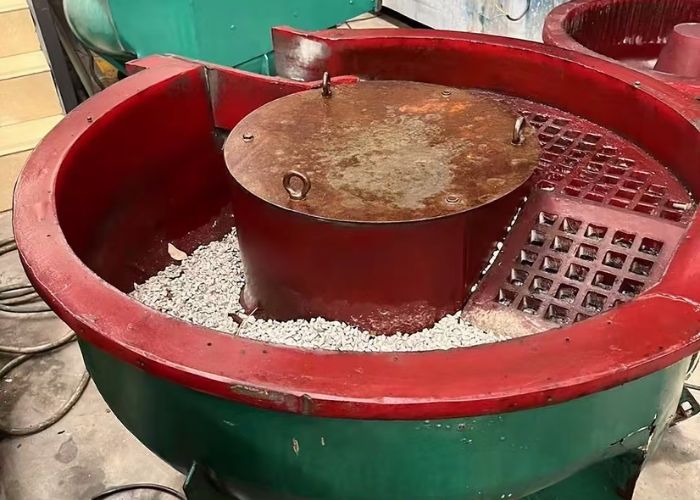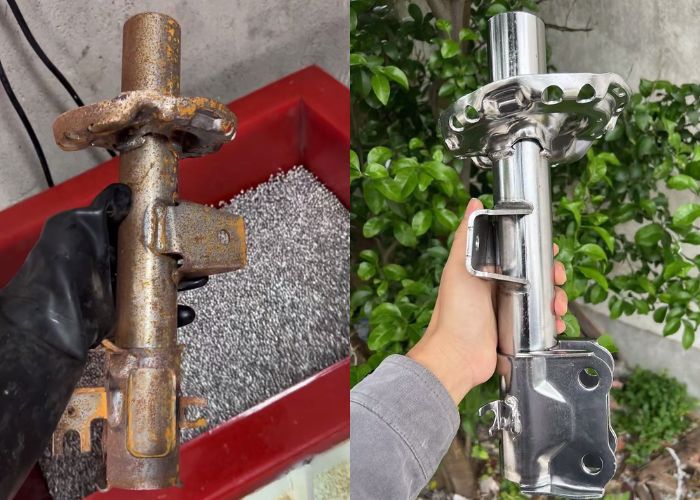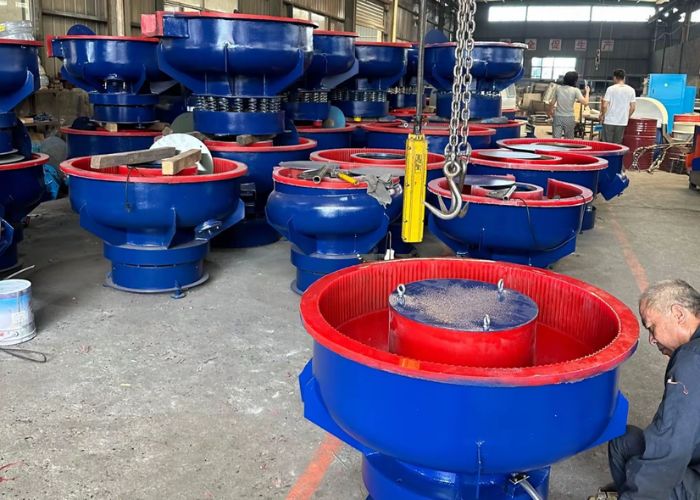Vibratory grinding is an efficient and precise surface treatment process widely used for deburring, polishing and flattening of industrial parts. By optimizing the vibration frequency and media selection, the process can handle complex shapes and multiple materials while ensuring high precision and consistency. Next, I will take you to explore vibration grinding in depth, from basic concepts to practical applications, to understand this important technology from all aspects.
何 Is Vibration Grinding?
Vibration grinding is a common process in our processing . Its principle is to use the vibration force generated by the vibration motor to make the grinding medium and the workpiece rub and collide with each other in the grinding groove, thereby achieving grinding treatment on the workpiece surface. It can remove burrs, oxide scale and other defects on the workpiece, making the workpiece surface smoother and flatter .
What Materials Are Suitable Fまたは Vibration Grinding?
In my long-term practice, I have found that different materials have different adaptability to vibration grinding. This depends not only on whether the material is metal or plastic, or ceramic or composite material , but also on the basic properties of the material such as hardness and toughness, and is closely related to the precision of the processing technology.

Next, I will talk in detail about the performance of various materials in vibration grinding :
Metal Materials
Metal materials such as 6061 aluminum alloy (commonly used in structural parts in the aerospace field and housing frames of electronic equipment, etc.), 45 steel (widely used in shafts, gears and other parts in mechanical manufacturing), etc., have high hardness and can withstand the impact of abrasive media.
After vibration grinding, the surface finish is greatly improved. Metal parts such as the crankshaft of the automobile engine (generally made of high-strength alloy steel) and the automobile wheel hub (commonly made of aluminum alloy) have better performance after this treatment. In the manufacture of automobile engines, metal parts are subjected to vibration grinding to reduce the surface roughness, making the engine run more smoothly and the power output more stable, effectively improving the overall performance of the car.
According to relevant data, the surface roughness of metal engine parts that have undergone vibration grinding can be reduced from the original Ra3.2μm to Ra0.8 – Ra1.6μm, which greatly reduces the friction loss between parts, improves the mechanical efficiency of the engine, and increases the power transmission efficiency by 5% – 8%.
Plastic Material
Some thermoplastics, such as ABS plastic (widely used in home appliance housings, toys, office supplies, etc.), are suitable for vibration grinding. By properly selecting grinding parameters, plastic deformation can be avoided and surface quality can be improved.
For example, the shell parts of some children’s plastic toy cars (usually made of ABS material) feel smoother after vibration grinding. In addition, in the processing of plastic shells of laptop computers (mostly ABS or PC+ABS alloy plastics), vibration grinding can remove defects on the plastic surface, making its appearance more refined without affecting the original performance of the plastic, thus meeting the product’s aesthetic and practical needs.
Let’s take a certain brand of laptop computer shell as an example. After vibration grinding, the glossiness of the shell surface increased by 30% – 40%, and the surface roughness decreased from Ra1.6μm to about Ra0.8μm, which effectively improved the texture and appearance quality of the product, making it more competitive in the market, and reduced the product defective rate by 10% – 15%.
Ceramic Materials
Ceramic materials such as alumina ceramics (commonly used in electronic ceramics, cutting tools, wear-resistant parts, etc.) and zirconia ceramics (used in dental restorations, jewelry, high-end ceramic cutting tools, etc.) are brittle, so the vibration intensity and time must be controlled during grinding to reduce breakage.
Appropriate treatment can improve the precision and glossiness of ceramic products, such as fine ceramic crafts (such as blue and white porcelain bottles, whose bodies are mostly made of ceramic materials such as kaolin). In the production process of high-end ceramic tableware (such as bone china tableware, the main ingredients include bone ash, kaolin, quartz and feldspar, etc.), after carefully controlled vibration grinding, the surface of the tableware is smoother and more delicate, which not only improves the aesthetics, but also enhances the safety and comfort of use.
According to the world’s known experimental data, the surface roughness of ceramic tableware after optimized vibration grinding parameters can reach Ra0.4 – Ra0.8μm, and the glossiness of the glaze is improved by 20% – 30%, greatly improving the quality and market value of the product.
Composites
Composite materials such as carbon fiber reinforced epoxy resin composites (used in the aerospace field for aircraft wings, fuselages and other structural parts, and in the sporting goods field for high-end rackets, bicycle frames, etc.), glass fiber reinforced polyester composites (commonly used in shipbuilding, automobile body parts, building panels, etc.) can effectively improve their surface properties and enhance the bonding strength between different materials by adjusting the grinding process according to their composition.
For example, the performance of carbon fiber reinforced composite materials is more stable after grinding. In the aerospace field, the wings of a certain type of aircraft are made of carbon fiber composite materials. After vibration grinding, the flatness and smoothness of the surface are optimized, reducing air resistance and improving the flight efficiency and safety of the aircraft.
Based on wind tunnel test data , we know that after vibration grinding, the surface drag coefficient of the wing is reduced by 8% – 12%, and the fuel efficiency is increased by 5% – 7%, which effectively improves the performance and economy of the aircraft. At the same time, it enhances the connection reliability between structural parts and extends the fatigue life by 15% – 20%.
Vibration Grinding Core Parameters
In the operation of vibration grinding, the precise control of core parameters is crucial. They influence each other and are closely related, directly determining the grinding effect and quality. Among them, the frequency amplitude and load speed are the key parameters , which promote the grinding process .
Next, I will analyze in detail the importance of each of them and the synergy between them.
The Role Of Frequency Amplitude
Frequency and amplitude directly affect the grinding effect. Generally speaking, higher frequency and moderate amplitude can make the grinding media hit the workpiece more actively and speed up the grinding speed, but too high frequency may cause damage to the workpiece surface.
For example, when processing small precision metal parts, I will control the frequency to 1500-2000 times/minute and the amplitude to 3-5mm, which can ensure both efficiency and quality, and make the surface roughness of the workpiece reach Ra0.8-Ra1.6μm. This fine parameter adjustment makes the metal parts more accurate and reliable in subsequent assembly and use, and improves the stability of the entire product.
効果 Of Load And Speed
Load is the ratio of workpiece to grinding media. Appropriate load can ensure grinding uniformity. Speed is related to grinding efficiency. Too fast speed may cause uneven distribution of media.
I usually control the load at 30% – 50% of the volume of the grinding tank, and adjust the vibration plate speed according to the material and shape of the workpiece to ensure that each workpiece can be fully ground and reduce the scrap rate. When producing large batches of small metal parts, reasonable load and speed settings greatly improve production efficiency and ensure product quality consistency .
Significant Advantages Of Vibration Grinding
In the process of long-term involvement in production practice and in-depth application of vibration grinding technology, I have truly and deeply realized its huge value and influence. It not only qualitatively improves product quality and achieves a substantial leap in production efficiency, but also achieves remarkable results in cost control.

Surface Quality Improvement
After vibration grinding, the surface roughness of our workpieces can be reduced by 30% – 60%, tiny defects are removed, the appearance is more beautiful, and the corrosion resistance and wear resistance of the product can be improved.
For example, a set of stainless steel tableware will become brighter and more durable after being ground . In daily life, it not only increases the service life of the tableware, but also brings a better user experience, making it more popular in the market. Competitive.
効率性 And Cost-Effectiveness
Compared with traditional manual grinding, vibration grinding efficiency can be increased by 5-10 times while reducing labor costs. Moreover, the grinding media can be reused, which reduces material consumption costs and has obvious advantages in large-scale production.
For example, after a hardware processing factory adopts vibration grinding, the output can be greatly increased, the cost is reduced, and the profit margin of the enterprise has been significantly expanded, providing strong support for the sustainable development of the enterprise.
Multifunctional Applicability
We found that vibration grinding can process workpieces of various shapes and sizes, from tiny electronic parts to large mechanical parts. As long as the parameters are adjusted properly, the ideal grinding effect can be achieved, which is difficult to match by many other grinding methods. Metal housings of mobile phones and large engine crankshafts can be optimized through vibration grinding, meeting the diverse needs of different industries for product surface treatment .
Vibration Grinding Technology Comparison
is well known for its unique advantages and distinctive characteristics . When we compare and analyze it with tumbling grinding technology and sandblasting technology in detail, we can more clearly and intuitively see the great value of vibration grinding.
following table details the differences and advantages of vibration grinding over other technologies :
| Comparison Dimensions | Vibration grinding | Tumble grinding | Sandblasting technology |
| How it works | Vibration allows the medium to fully contact the workpiece, achieving deburring and surface polishing | Surface treatment is completed by rolling and colliding the workpiece | High-speed sand flow impacts the workpiece surface to remove oxide layers and impurities |
| Applicable workpiece type | Suitable for complex-shaped workpieces, such as automobile engine blocks and precision gears | Suitable for small, simple shaped parts | Suitable for large surface cleaning, such as large mechanical housing or pre-painting treatment |
| Surface quality | The surface flatness is high, the roughness can be reduced by 20%-40%, and the accuracy is suitable for precision industries | Rough surface treatment, suitable for basic deburring | It is easy to cause micro deformation of the surface and high roughness |
| 効率性 | High efficiency, 30% faster than tumble grinding, capable of processing multiple complex workpieces at the same time | Less efficient, takes longer to achieve basic grinding effect | High efficiency, suitable for fast cleaning of large surfaces |
| Material damage | Little damage to the workpiece, suitable for scenes with high requirements on surface quality | Prone to edge wear, not suitable for thin-walled parts | High impact force may cause micro cracks or deformation on the surface |
| Typical Applications | Surface polishing of aviation parts, medical equipment components, and complex metal parts | Small machine parts produced in batches, such as screws and washers | Large steel structural parts, machine casings, pre-processed metal parts |
| メリット | High surface quality, strong adaptability, able to handle complex-shaped workpieces, saving time | Low cost, suitable for large-volume basic processing | High efficiency, suitable for large-area oxidation layer removal treatment |
| デメリット | Equipment cost is high and suitable for high-demand scenarios | Low efficiency, average surface treatment effect | The surface may be deformed by impact, suitable for processing non-precision parts |
| Specific cases | The surface finish of aerospace parts has been improved to Ra 0.8, and the fatigue strength has been significantly improved. | Basic metal gasket deburring | Large-scale mechanical sandblasting and rust removal, surface treatment is fast, but subsequent processing is required |
| Applicable industries | Aerospace, medical equipment, automobile manufacturing | Basic industrial manufacturing, low-precision mechanical parts | Steel structure manufacturing, mechanical equipment appearance treatment |
From the above comparison, we can see that vibration grinding has irreplaceable advantages in fields that require high precision and high performance due to its excellent surface quality control and multifunctional adaptability. Tumble grinding and sandblasting technology each have their own applicable scenarios, meeting the basic processing needs of low cost and high efficiency respectively.
Vibration Grinding Applications
Vibration grinding technology plays an indispensable role in different industries. From basic metal processing to high-end medical device manufacturing, it can be seen everywhere. I will take you into these fields to see how vibration grinding helps improve product quality.

メタル P処理 Fイールド
In metal processing, vibration grinding is widely used in various parts of machinery manufacturing to metal components for construction. For example, the cutting performance of machine tool tools is improved after grinding, and the service life is extended by 20% – 30%, which ensures the accuracy and efficiency of metal processing. In machinery manufacturing enterprises, high-precision machine tool tools are the key to producing high-quality products. The application of vibration grinding technology has made a qualitative leap in the performance of tools, improving the production efficiency and product quality of enterprises.
Precision Equipment Manufacturing
For parts of precision instruments, vibration grinding can meet their high-precision surface requirements. For example, watch parts can reach micron-level dimensional accuracy after fine grinding, ensuring the watch’s accurate timekeeping and stable performance.
In the high-end watch manufacturing industry, every tiny part is related to the quality and value of the watch. Vibration grinding technology provides a reliable guarantee for the precision manufacturing of watches, making watches a representative of precision craftsmanship.
Decoration And Crafts
In the field of decoration and handicrafts, vibration grinding can add unique luster and texture to materials such as metals and ceramics. For example, after grinding, the texture of copper handicrafts is clearer and the color is brighter, which enhances the artistic value.
In the production of traditional handicrafts, vibration grinding technology has injected new vitality into the ancient craft, making the handicrafts more exquisite and satisfying people’s pursuit of beauty and demand for cultural heritage.
エレクトロニクス産業
The metal shell and internal parts of electronic equipment are polished by vibration to remove burrs and oil, ensuring the appearance and performance of electronic products. For example, the middle frame of a mobile phone can be assembled more tightly and the signal transmission is more stable after polishing. In the electronic information age, the quality and performance of electronic products are crucial. The application of vibration polishing technology improves the overall quality of electronic products and brings a better experience to people’s lives.
Medical Device Industry
High-precision parts of medical devices require smooth surfaces to ensure safe use. For example, after vibration grinding, surgical instruments have a high surface finish, which is not easy to breed bacteria and reduces medical risks. In the field of medical devices that are related to people’s life and health, the application of vibration grinding technology is a strong guarantee for patient safety and embodies the combination of science and technology and humanistic care.
Jewelry Processing
The metal parts of jewelry become more dazzling after vibration grinding. For example, the gold necklace is finely ground to enhance its glossiness, which can better show its luxurious quality and satisfy consumers’ pursuit of beauty.
In the fascinating jewelry industry, vibration grinding technology allows each piece of jewelry to shine with unique brilliance, becoming a work of art that people treasure and wear.
よくある質問
Can Vibratory Grinding Pプロセス All Types Of Materials?
Vibration grinding cannot process all materials. However , it is applicable to metals, some plastics, ceramics and composite materials. We need to select parameters according to the material characteristics. For example, flexible materials such as rubber are not suitable because they cannot withstand the impact caused by grinding .
どのように To Determine T彼 Optimal Parameter Settings Fまたは Vibratory Grinding?
There is no fixed optimal parameter for vibration grinding . We should consider factors such as workpiece material, shape and desired effect to set the parameters . For example, for aluminum alloy parts, I first grind at a frequency of 1800 times/minute and an amplitude of 4mm, and then adjust according to the surface quality. After multiple tests, I determine the optimal parameters.
何 Media Is Used In Vibration Grinding?
Commonly used ceramics, stainless steel, silicon carbide, etc. Ceramics are suitable for fine grinding, stainless steel is used for high-intensity grinding, silicon carbide has high hardness and is suitable for grinding wear-resistant materials. The selection depends on the workpiece requirements.
何 Is T彼 Service Life Of Vibrating Grinding Media?
Stainless steel media: 6 months to 1 year, ceramic media: about 1 to 2 years, silicon carbide media: about 1.5 to 2 years , it all depends on the frequency and intensity of use. Frequent use will cause the media to wear and break, affecting the grinding effect, and needs to be checked and replaced regularly.
何 Are T彼 Benefits Of Vibration Grinding?
From the data analysis, we can know that vibration grinding can reduce surface roughness by 30% – 60%, increase efficiency by 5 – 10 times, reduce labor costs by 40% – 60%, and improve product corrosion resistance and wear resistance, thereby enhancing market competitiveness.
どのように Effective Is Vibration Grinding?
vibration grinding , our products appear smoother and flatter on the surface . Through a series of tests, it can be found that the roughness of the products meets the standards , and the crystal structure is denser at the microscopic level . The corrosion resistance and wear resistance are enhanced, and the product qualification rate is increased by 20% – 30%, which can effectively improve the overall quality of the products.
Cまとめ
Through the introduction of vibration grinding technology, we can understand its key contents such as its principle, applicable materials, core parameters, advantages, technology comparison and application fields. In actual production, the rational use of vibration grinding technology can significantly improve product quality and production efficiency, reduce costs, and provide strong support for the development of various industries.
